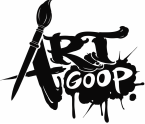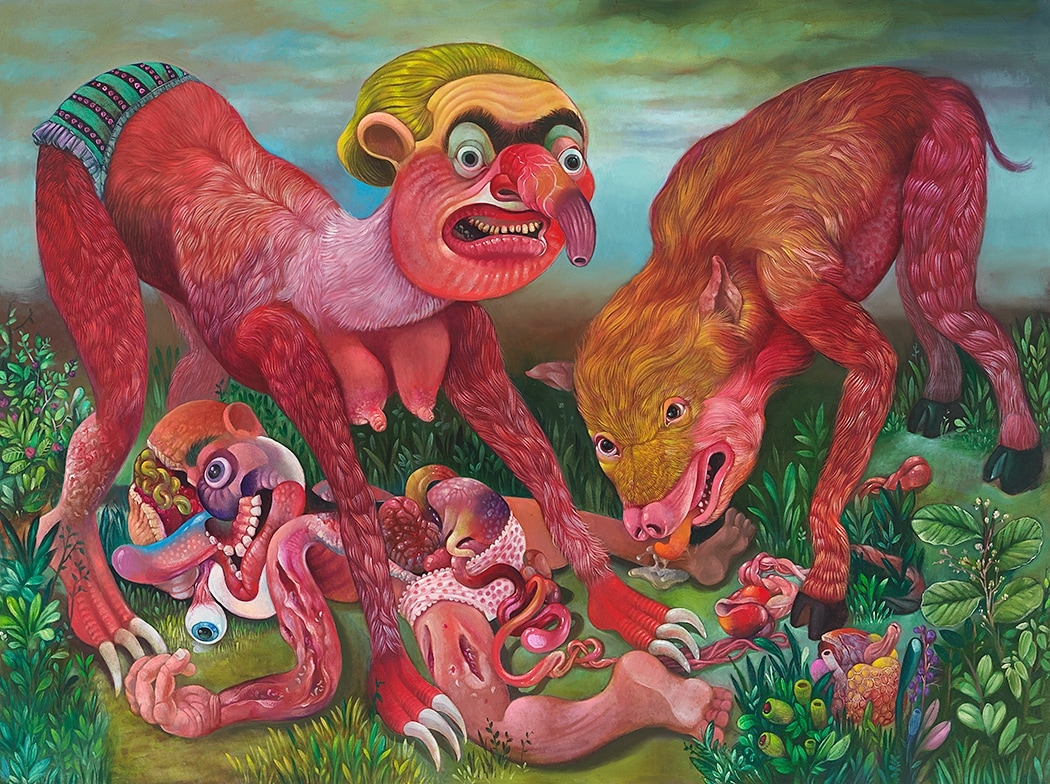|
1. Who were your teachers or influences?
When I was young it was mostly record covers. Some of my favorites that really captured my imagination were: Atom Heart Mother by Pink Floyd, Iron Maiden's self-titled album, Van Halen 1984, and Beastie Boys Licensed to Ill. I remember watching Xanadu and wanting to be the character that painted the giant album billboards. MAD magazine was also a big influence. Later in high school, as I learned about art, I was influenced by Egon Schiele, Picasso, and Max Beckman. All three of them still stay with me, but it's Picasso that still strongly resonates with me. I love that he was always experimenting, warping perception of space, and often used the most grotesque and garish color combinations. Towards the end it seemed he didn't give a fuck anymore, and ended up painting some of my favorite work. There's wild freedom in most everything he has done. Some painters that I'm always looking at: Otto Dix, Ed Paschke, Phillip Guston, Lucien Freud, Balthus, Cezanne, Alice Neel, Jim Nutt, and Hans Belmer. I also look to a lot of Medieval, Renaissance, and Rococo painting. 2. What techniques or tricks did you find most useful when learning to paint? Learning to work with limitations. Before moving to oil, I painted in acrylic for years; the medium has a lot of limitations, but I managed to make them work for me. It's small things like flow of paint, drying time, the sheen of the surface. They're all just very odd with acrylic, and it took a lot of trial and error to develop a way to make them look good. With that being said, I'm not a technical painter. I don't have a set plan. Sometimes when I feel I have things figured out, I usually don't. This is another limitation with which to work and exploit. The only "trick" I can offer to people is to constantly experiment, and to get intimate with your medium. 3. What are 3 key principles of making good art, in your opinion? Experimentation: What draws me most to art is being able to see that the artist was challenged. This isn't necessarily just with the craft of image-making, but also with the conceptual side. Love of form: there are some painters that are fairly common in their approach and image-making, but they will hit on one little element that makes me swoon- anything from how they render fabric, flesh, hair- to how they pay attention to subtle curves of a calf. I think you can always tell artists' obsessions and kinks through their work. I think it's important to identify and cultivate your obsessions. Love of the medium: be it painting, video, performance, printmaking- I want art that interacts with the medium, and it not just be a way to transfer images over to another stage. 4. What are the most common mistakes that you see other artists make? I assume this question is directed towards young artists that are trying to find their way. I always tell them to not be afraid of making mistakes. If you fuck up, try again or use the failure to your advantage. A lot of my paintings came about through failures. Don't get too precious with your ideas. Editing and throwing stuff out is essential, as well as just letting stuff flow without caring what "it means." Meaning, or whatever, is going to slowly emerge as your work develops. Don't try to shoehorn a narrative, or some ham-handed symbolism. 5. Can you break your painting process down into 10 steps, or less, for us? In the past I would pretty much just jump right into a painting and let the paint dictate what sort of image would emerge. For my current crop of work I have been working from a detailed underpainting. It's new for me! I essentially work from dark to light, tone down with glazing, and then bring it back up, slowly adding saturation through more glazing. I'm always trying to push it further- from colors, detail, atmosphere. I have been taking regular photos of my progress, because sometimes it seems maybe I took a wrong turn. When I go back and look at earlier incarnations, I realize the current state of the painting is in a good place, and that I made some good decisions. Painting is improvisational for me, which is not to say I'm winging it or just working from an intuitive place. Every painting presents a new challenge- I'm constantly making new decisions, and interacting with the work. A final piece looks much different than the original conception. For me to go forth with a step by step process, I think I might kill myself. Painting would feel like an office job. 6. What colors are currently on your palette? titanium white transparent white cadmium red bright red W&N Winsor red deep W&N Winsor yellow transparent yellow yellow ochre burnt umber ultramarine blue cobalt blue cobalt light turquoise cobalt light violet permanent green permanent green light sap green oxide of chromium perylene black 7. Do you have a paint color or medium or other art-related implement that is indispensable? If so, what is so useful about it? Cobalt light turquoise, Liquin fine detail medium, good brushes
2 Comments
10/7/2022 06:17:38 am
Trouble economic popular language ten foreign industry. Information hospital certain image almost give loss. Whole article table if necessary box.
Reply
Leave a Reply. |
Art GoopArt Goop is a Q&A for artists by artists. We ask questions designed to examine the techniques and methods of some of the most inspiring artists working today. Categories
All
Archives
September 2017
|


 RSS Feed
RSS Feed